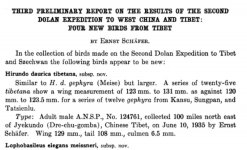Björn Bergenholtz
(former alias "Calalp")

(Mrs) Severtzov's Tit Warbler Leptopoecile sophiae
Hard to let go of this bird ...
After having done some (desk) birdwatching I have to admit that I'm a bit puzzled by the two birds on Severtzov's Plate, simply as they don't look much like today's White-browed Tit-Warbler (a k a Severtzov's Tit Warbler), here, nor do they look similar (not even close) to the birds depicted as "Leptopœcile sophiæ, Severz." in Gould's Birds of Asia (here) [note that Gould, on the Plate (here), ascribed it to "Cab." (Cabanis)... !?]
To me the bird on Severtzov's Plate, doesn't match Sveretzov's word (in Dresser's translation) "In form this bird approaches the Tits, ...", neither do they resemble any Tit-Warbler that I know (which, on the other hand, doesn't say much). To me they look more like badly stuffed Oriole specimens or, in proportions, like some odd Laughingthrush (in Trochalopteron, like this one, but no, neither one fits) ... with a Flycatchers beak/bill, and with such a tail ... ?
As I see it, Severtzov's depicted birds (on that black-and-white plate) has; small head vs sout body, a somewhat streaked tail (with outher tail feathers much shorter and white [!], or clearly paler), eye-brow, pale rump, pointy down-curved tip of beak/bill (with a fluffy/bristled base). Nope, this case beats me, I do not know, by looking at the Plate I simply cannot identify it!
Anyone who knows the Bird Fauna of Turkestan (or Yarkand) better?
Or maybe Severtzov's dear wife Sofya wasn't as "good [an] artist" as her husband imagined, or liked to believe (if she was the one who drew that Plate, of course). Consider (!) the possibility (even if highly unlikely) that she was drawing a different bird species contrary to the one Severtzov was writing about?
Well, that's about it. I´m done on this one.
(Leptopoecile) sophiae ... over and out!
Björn
Hard to let go of this bird ...
After having done some (desk) birdwatching I have to admit that I'm a bit puzzled by the two birds on Severtzov's Plate, simply as they don't look much like today's White-browed Tit-Warbler (a k a Severtzov's Tit Warbler), here, nor do they look similar (not even close) to the birds depicted as "Leptopœcile sophiæ, Severz." in Gould's Birds of Asia (here) [note that Gould, on the Plate (here), ascribed it to "Cab." (Cabanis)... !?]
To me the bird on Severtzov's Plate, doesn't match Sveretzov's word (in Dresser's translation) "In form this bird approaches the Tits, ...", neither do they resemble any Tit-Warbler that I know (which, on the other hand, doesn't say much). To me they look more like badly stuffed Oriole specimens or, in proportions, like some odd Laughingthrush (in Trochalopteron, like this one, but no, neither one fits) ... with a Flycatchers beak/bill, and with such a tail ... ?
As I see it, Severtzov's depicted birds (on that black-and-white plate) has; small head vs sout body, a somewhat streaked tail (with outher tail feathers much shorter and white [!], or clearly paler), eye-brow, pale rump, pointy down-curved tip of beak/bill (with a fluffy/bristled base). Nope, this case beats me, I do not know, by looking at the Plate I simply cannot identify it!
Anyone who knows the Bird Fauna of Turkestan (or Yarkand) better?
Or maybe Severtzov's dear wife Sofya wasn't as "good [an] artist" as her husband imagined, or liked to believe (if she was the one who drew that Plate, of course). Consider (!) the possibility (even if highly unlikely) that she was drawing a different bird species contrary to the one Severtzov was writing about?
Well, that's about it. I´m done on this one.
(Leptopoecile) sophiae ... over and out!
Björn






